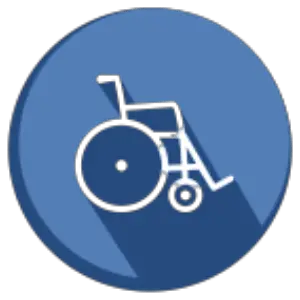This post may contains affiliate links.
This means I will make a commission at no extra cost to you should you click through and make a purchase.
Gardening is not just a simple hobby, popular activity, our obsession, it is one of the best ways to stay relax, relieve stress, and exercise your mind.
Starting a Wheelchair Accessible Garden is the most efficient way to inactively stay active. Since gardening is a practical activity, you exercise your hands and build up strength around your arm muscles.
Since gardening is an outdoor activity, you also get exposed to natural Vitamin D, which increases your calcium levels and leads to strong bones and teeth.
Now that you’ve seen the beauty of gardening, this article will walk you through the best ways to set up a wheelchair-accessible garden.
How Can I Start A Garden From My Wheelchair?
Raised beds are one of the easiest ways to manage a garden from your wheelchair. As long as the raised beds are at least 24” off the ground, a person in a wheelchair should be able to work comfortably.
The most important thing you should try to remember about wheelchair gardening is that you need a modified garden bed or adapted gardening tools before you can effectively run a garden from your wheelchair.
You need to raise garden beds or hanging baskets to keep the plants at a level that is easier for you to reach. Raised beds or hanging baskets will allow wheelchair-bound gardeners to start and maintain a garden.
Both raised beds and hanging baskets provide the same benefits as traditional gardening.
The bed, hanging basket, or plants should be placed in an elevated position [about 35 inches of the ground]. Since it is a raised garden, you have 87% control of the soil quality in your garden.
Raised gardens position the plants and flowers at a height that is convenient for you to reach from your wheelchair. This way, you don’t have to kneel, strain your body, or squat whenever you want to tend to your plants.
How Do I Build A Raised Garden?

Before you build a tabletop garden, you need a sheet of paper or whiteboard to design the layout or style you want for a tabletop garden.
Once you have a design you like, get the materials you need to bring your design to like. For this guide, we will make our raised garden out of wood.
Raised beds are usually made of rot-resistant wood. You can also make raised garden beds with cement brick, plastic timbers, aluminum, and metal sheet.
You can make your own raised bed at home using wooden beams, plywood, and decking screws.
You can use any design of your choice, I will only provide you with the recommended measurement.
Raised beds are usually 4 feet wide and 24 inches tall. This is the perfect measurement for a wheelchair garden.
As long as no bed is four feet wide, the gardener should be able to stretch his hands from either side of the platform. If you create a raised garden bed longer than four feet, it may be difficult for wheelchair users to reach some plants or certain parts of the platform.
As for the height, you should make the raised bed anywhere between 28 and 34 inches tall. This is the optimal height of a raised garden bed for someone seated in a wheelchair.
If the person uses a rollator, walker, or crutches, the raised garden bed should be 30 inches tall.
Raised beds and tabletops gardens allow for easy wheelchair access. A good raised garden bed should be shaped or designed like a dining table.
This would allow the gardener in a wheelchair to position his laps underneath the table and comfortably work on his garden. If there’s no space under the table, a side approach will work just fine.
Once you’ve built the raised bed, the next thing is to fill it with soil and fertilizer. Mix the soil and fertilizer evenly and add enough water to settle any air pockets.
Gardening in a wheelchair may seem like an impossible task, but this setup would allow you to start and manage a garden from your wheelchair.
Alternatively, there are other hacks that you can try out without building a raised garden bed or buying a hanging basket.
The easiest way to set up a raised garden is by placing your planter, gardening pots, or flower beds on an elevated surface. Any elevated surface like the frame of your bedroom window, concrete slab, pavement, balcony, or a small fence.
Once you have a height or surface that is easy for you to access from your wheelchair, you can place your planter or gardening pot on the elevated surface.
If you don’t have any elevated surface around you, consider building a raised garden or purchase one from a hardware store.
If you plan to purchase a raised garden bed, we recommend the WOG Red Cedar ADA Compliant Raised Garden Bed.
If you prefer a plastic raised bed, go for the Vegepod Raised Beds or the Taleco Gear Vertical Freestanding Elevated Planter. They last longer and have a ventilated propagator cover that protects your plants from harsh weather and pests.
Whether you decide to purchase/construct raised garden beds or simply place a few garden pots on an elevated surface is completely up to you. Both techniques are affordable and wheelchair accessible.
Tools Needed For Gardening In A Wheelchair
With the right tools, wheelchair gardening can be a lot of fun.
There are a lot of gardening tools that can make it easier for you to weed, plant, water, and cultivate crops in your garden even from a wheelchair.
There are adaptive gardening tools available for wheelchair users. These tools aren’t just practical; they can help you take your gardening skills to a completely new level.
Here’s a list of the recommended tools and gears for wheelchair gardening.
1. Hanging Baskets or Raised Beds
Hanging baskets and raised beds is the first and most important equipment you need to start and manage a garden from your wheelchair.
Since you can squat or kneel, you’d need hanging baskets, raised beds, or garden pots placed on an elevated surface to reach the plants from your wheelchair.
As long as the garden bed and baskets are at least 24 inches off the ground, you can care for your plants from your wheelchair without stress.
It’s easier and more relaxing to garden from a raised garden bed. You’ll never have to bend over or leave your wheelchair to tend to your plants.
2. Gardening Gloves
Just because you have a small garden doesn’t mean that you shouldn’t get a pair of garden gloves. Gardening gloves will protect your hands from blisters, thorns, and allergic reactions from contact with certain plants or objects in your garden.
Garden gloves also prevent dirt and soil from getting into fingernails. It also keeps your hands clean and warm.
While many people still don’t see it as a necessity, it is one of the most important tools on this list. Lisa and I always have a pair of gloves on whenever we are working on our garden.
3. Pruning Shears
Pruning shears are also known as hand pruners or secateurs are one of the most important tools in wheelchair gardening. Pruning is a very important part of gardening, whether you’re tending to flowers or harvesting berries from your garden.
This handy tool will help you get rid of dead leaves, branches, and buds that are still absorbing energy and preventing your plants from growing.
4. Collapsible Garden Bucket
If you’ve scaled your garden from containers to beds or you have enough room for disposing of your garden waste after pruning or weeding.
A collapsible garden bucket would allow you to carry the waste to the nearest recycling bin or keep it in a corner of your garden to serve as manure.
5. Hand trowel
You also need a hand-held trowel if you plan to enjoy your gardening experience.
This adaptive gardening tool makes it easy for you to handle delicate gardening operations like digging small holes, planting seeds, mixing the soil, transplanting seedlings, digging up weeds, breaking up clumps of soil.
Since they are small and lightweight, you won’t have any issue using them from a mobility vehicle. As long as you have a sturdy grip, hand trowels would simplify almost everything you do in your garden.
6. Radio Flyer 36″ All-Terrain Steel & Wood Wagon
Finally, you’ll need small wagons or roller-totes to move items around your garden.
It will be difficult to push a wheelbarrow from a wheelchair but a cart like the Radio Flyer 36″ All-Terrain Steel & Wood Wagon would allow you to transport seeds, gardening pots, trays, rock phosphate, manure, and your gardening tools all at once.
It is one of the best ways for wheelchair-bound gardeners to move stuff around their garden. If you are not comfortable using a Radio Flyer Wagon, you can get a plastic wheelbarrow [I recommend the Two Wheeled VonHaus 78L Wheelbarrow].
Plastic wheelbarrows are inexpensive and lightweight, which makes them perfect for gardening. You can use this handy tool to transport larger quantities of soil, mulch, plants, and a bountiful harvest.
You should also check out FredShed for more reviews and insights on wheelchair gardening, tools, and reviews.
Tips For Gardening In A Wheelchair
Wheelchair gardening is a recommended activity for physically impaired persons who have fewer options when it comes to getting into the natural environment.
Being disabled can make getting into nature pretty difficult. If wheelchair gardening is what you have been confined to, congratulations I have a long list of tips and guidelines that would make your wheelchair gardening journey worth it.
Regardless of the limitation being wheelchair-bound may pose, these tips will prove how possible it is to have and cultivate a garden even in a wheelchair.
1. Make Use of Ideal Heights and Widths for Garden Beds
The ideal heights for raised garden beds should be between 24 and 36 inches from the ground. This 24 – 36 inch altitude is recommended because it is slightly below the eye level when seated in a wheelchair.
If the raised bed is too high, it will be difficult for wheelchair gardeners to plant, weed, water, or harvest in the garden.
When gardening from a mobility vehicle, make sure that the garden bed is in an optimized position to prevent strain and fatigue around your arm.
For disabled gardeners that prefer an onward approach, 24-inches may not be the ideal height.
Some gardeners in a wheelchair prefer to keep their legs directly under the garden bed. In such scenarios, the ideal height for the garden beds should be 34-inches.
Anything higher than this will make you work at shoulder height, and that would be too very strenuous and uncomfortable.
If you already have a garden, you can also change it and create pathways that will make it wheelchair accessible. The garden’s pathways should be evenly spaced with at least 5” between each bed.
2. Ensure the Planter is Accessible
The goal of every wheelchair-accessible garden is to ensure that the beneficiary can easily and comfortably access every element in his garden.
The planter, raised beds, hanging baskets, or garden pots must be in such a way that the gardener can access it even though they are confined to a wheelchair.
While you are making sure the planter is accessible, ensure that it is positioned in a place where it can receive adequate sunlight. The planter’s position should ensure that each plant receives at least six hours of sunlight each day.
3. Keep Garden Tools Close
To ensure that you enjoy every moment from gardening from your wheelchair, make sure that every tool and equipment you need to manage your garden is in a close and accessible location.
When your garden tool is far from you, you can easily get discouraged and lose interest in the task at hand. As relaxing as wheelchair gardening is, you can easily call a quit if you constantly cannot reach the tools you need.
The perfect place to keep garden tools is on the raised garden beds, this will make the garden tools easily accessible whenever you are in your garden.
You can also hang your tools on any wall around your garden. This way, you can easily spot the required tool from a distance and pick it up when you need to.
4. Have a Seat Nearby
As much as most wheelchair gardeners would love to carry out their gardening enterprise alone, talking to a friend or family member can be a thrill while gardening.
Keeping a seat or two in your garden is would allow you to talk to friends and still work on your garden. Gardening provides a sense of hope, self-empowerment, and purpose.
This should not be taken from anyone, regardless of their disability. Gardening also offers a bit of value to life, and it would be a shame not to share that with a friend.
Besides, the plants would enjoy a pleasant conversation.
5. Adopt Low-Maintenance Gardening Methods
One thing you should always consider in wheelchair gardening is to use low-maintenance or budget-friendly approaches or techniques, especially if you are a beginner.
A budget-wise approach is important because managing a garden from a wheelchair can be difficult. You want to make sure that you adopt a low-cost approach if gardening is something you plan to do for a long time.
Your gardening process should be as simple as possible.
There are several ways to run a garden on a budget. You can use your kitchen waste as fertilizer or place mulch beneath plants to aid moisture in the soil.
Every instruction and tip in this article was leveraged from the experiences of several gardeners, florists, and wheelchair users that own and manage gardens as part of the therapeutic process.
Despite all the tips I shared in this article, there is still much more to know about wheelchair gardening. I just shared a handful of that will help you manage and grow gardens from wheelchairs.
here is a video of how to build a raised garden:
If you have questions or contributions to share, do tell using the comment section below.

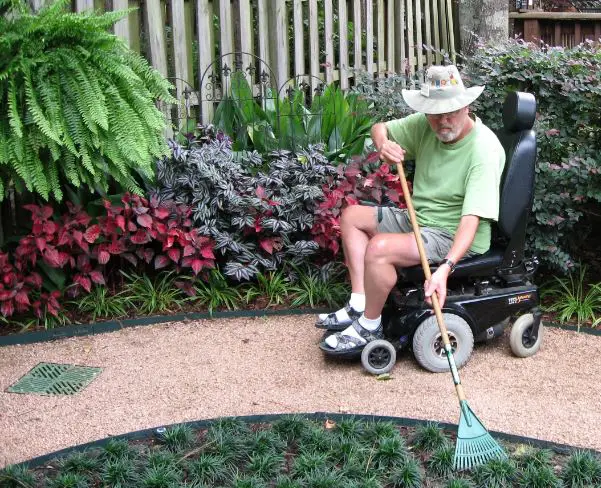
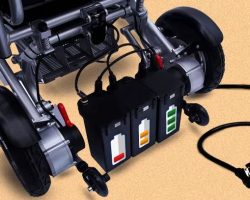
![Top 10 Best Wheelchair Cushions [2024 Review] Best Modern Wheelchair Cushion For Comfort and Convenience](https://wheelchaired.com/wp-content/uploads/2021/04/10-Best-Wheelchair-Cushions.jpg)
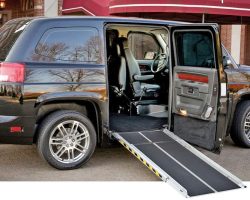

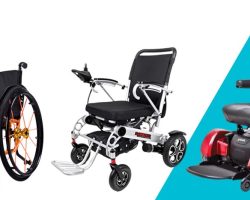
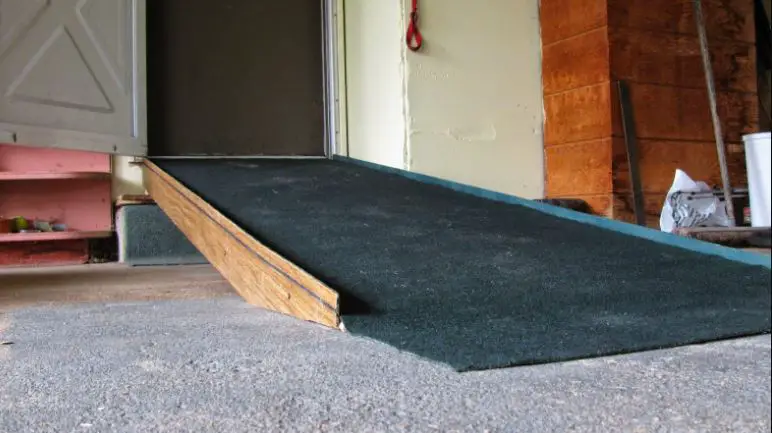
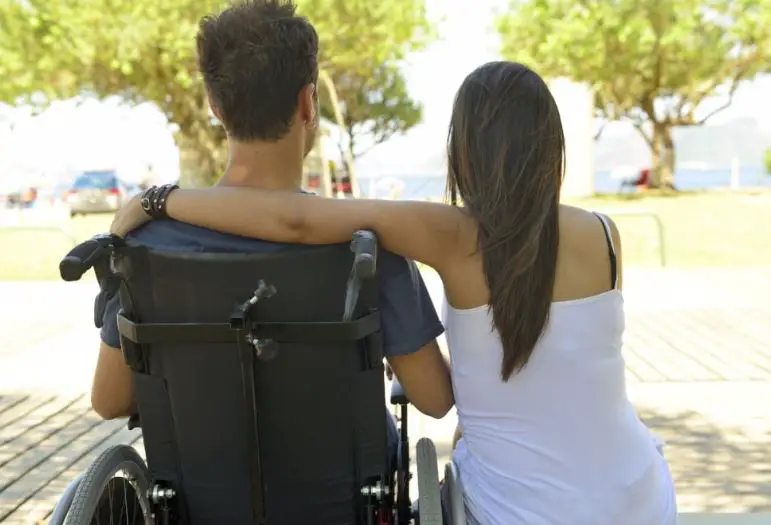

![Best Wheelchair Tires For Outdoor Use [2024 Review] Best Outdoor Wheelchair Tires](https://wheelchaired.com/wp-content/uploads/2022/02/Best-Outdoor-Wheelchair-Tires-250x200.jpg)
